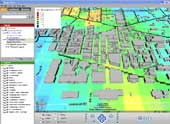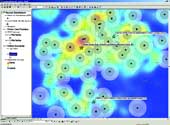Yes, Google Earth and Microsoft Virtual Earth have sizzle and pop. With this software, you simulate flying around the globe and zoom down to street level in virtually any major city in the world. You can pirouette around your old high school or look to see whose car is parked out in front of your ex-wife's house. (Though it's not in real time and neither product can yet let you read the license plate.)But despite all the 3-D sparkle of these Web map tools, if your agency wants to do serious geographic analysis, you're going to need a tool with more muscle.'It's a cool display, but that's what it is ' a display,' Doug Gordon, managing director of MapInfo's product management division, said of Google and Microsoft's offerings.'All you really can do [with those products] is create points and stick them on the globe. You can't offer large quantities of information about land parcels, natural resources or the census. You can't do high-quality cartography,' agreed David Maquire, director of products at ESRI.To do more in-depth geospatial analysis, you're going to need a full-fledged geographic information system, or GIS.GIS solutions offer more than just map displays. They combine the analytical power of databases with the geographic capabilities of maps. As a result, they can produce reports that show at a glance anything from demographic trends to the most appropriate site for a new hospital.The Centers for Disease Control and Prevention, for instance, found that GIS software could reveal trends that might be hard to spot by looking at the numbers alone.The agency uses GIS tools for its Interactive Atlas of Reproductive Health. This Web-based map application ' created using ESRI's family of GIS tools ' can be accessed using a simple browser and lets users search and display a variety of data, such as infant mortality, pregnancy outcome, infant health and maternal risks. Users also can choose to display data in a variety of ways, including by state or census division.'When we built the atlas, it was to address the needs of our family planning constituents, who need this information for health policy service decisions,' said Dabo Brantley, project leader for the Interactive Atlas of Reproductive Health.Already, the atlas has produced striking results, Brantley said. She recalled creating a map analysis that overlaid teen fertility in Texas on a map showing the locations of family planning clinics. The highest fertility rates were right along the state's southern border. What was interesting was that there were no family planning clinics in that area.'We work with the Office of Population Affairs,' Brantley said, 'and they came down and we showed them that map and they just couldn't believe it. You can look at this in tables all day. We have 300 family planning clinics in Texas, but you can't tell where they are. And you can look at an alphabetical listing of counties, but you can't tell how they relate to each other. On a map, it's really striking.'At present, the atlas doesn't have many advanced GIS capabilities. 'It's really just a glorified map book,' Brantley said. By late spring, however, she expects to add tools that will bring true GIS capabilities to the project. 'We're going to take the data we have now, update it with more years [of data], and we're going to add what we call resource layers than you can lay on top [of the maps].'GIS programs have long been used by engineers, transportation planners and other specialists to track and analyze geographically oriented data, from the location and age of utility lines to deforestation trends.The snag was that buying a GIS solution meant spending many thousands of dollars on software and thousands more on high-end workstations and training. In recent years, however, GIS programs have gotten both less expensive and easier to use, encouraging broader use in government for a variety of purposes. Local state and federal agencies have used GIS software to execute such tasks as:A variety of advanced tools give GIS programs such as those offered by MapInfo and ESRI the ability to perform such tricks.Suppose, for example, you want to determine the resources available along hurricane evacuation routes in Louisiana.Using the buffer tool in MapInfo Professional or ESRI ArcView, you would first select those routes and then create a buffer five miles wide on each side of the routes. You can then search within that area for all resources in your databases matching any specified criteria.Buffers aren't, of course, the only analytical tool. High-end GIS solutions can perform line-of-sight analyses that can, for example, aid in determining obstacles for radio waves or air traffic. Routing tools let users track mobile assets and calculate the best routes to a destination. Geocoding tools allow data to be attached to geographic features ' such as street addresses, ZIP codes or census tracts ' for subsequent analysis and display.What's more, full-featured GIS programs such as ArcView and MapInfo also offer far more choices when it comes to displaying map data. While Google Earth and Microsoft Virtual Earth let you overlay a layer of data on a map, full-featured GIS systems let you perform multiple overlays and complex data analysis. Want to display crime rates broken down by county or census tracts? You can create theme maps that color-code each sector according to their rates. You can also apply multiple-theme overlays using other characteristics, such as texture, dot density, pie charts or even 3-D extrusions.In addition to the robust set of tools on program menus, full-featured GIS programs offer broad support for both database formats and map projections. That might seem rather dry, but it matters. Without such support you could have huge amounts of data that you want to use but can't.'If you get data from the national map and you have some data in the Texas State Plane Coordinate System from your local database, and you want to combine the two together, you can't do that in Google Earth or Microsoft Virtual Earth because they don't have accurate projection engines,' ESRI's Maguire said.ESRI's ArcView makes it easy to bring in and project such data, he said. What's more, GIS vendors offer scalability to agencies and departments that the Web mapping programs can't deliver.'From a customer's perspective, they almost never come to us and say, 'Tell us about your one product,' ' MapInfo's Gordon said. 'They come to us with a business problem and ask how we would address it. It could be a combination of products.'Both MapInfo and ESRI offer Web browser-based clients and Web server software to deliver content in much the same way as Google Earth and Microsoft Virtual Earth, though with more analytical and display tools.The vendors also offer robust desktop programs for creating more advanced map features, integrating data and performing sophisticated data analysis. Both companies also offer extensive data sets and modules for performing specialized chores, such as 3-D analysis and trade zone analysis.Most advanced GIS programs also are programmable so that you ' or, more likely, a trained consultant ' can create customized applications that more efficiently suit your data analysis and mapping needs.The Department of Homeland Security on March 17 unveiled its own ambitious GIS project: the Infrastructure Critical Asset Viewer. ICAV will be used to coordinate geographic information about the nation's critical infrastructure with emergency response and other security resources.ICAV will provide 'operational, situational and strategic awareness of homeland security-specific mission focus,' said Steven Alness, manager of DHS' Geospatial Programs Office. The system will be used to loop in state, local and other federal agencies as well as private-sector partners.'For instance,' Alness said, 'Hurricane Katrina could be plotted on the map and the code of uncertainty for that hurricane track could be correlated with the nation's infrastructure. It gives you that visual context in a dynamic near-real-time or real-time.'The system will help responders at the federal, state and local level understand threats and vulnerabilities as well as efficiently coordinate responses.Alness added that one great feature of the platform, which was built with ESRI software, is that users can access it using nothing more than a Web browser. At the same time, they'll have access to sophisticated GIS tools, such as distance plotting and address matching.The power of the GIS application, said Alness is that it helps tie together mission-specific elements to give a 'total common operating picture.'
EXTRA LAYERS: MapInfo Professional lets you build varied demographic profiles of citiies such as Washington.
HEALTH TRACK: Health agencies can use programs such as ESRI ArcView to keep track of vaccine points of distribution, such as this example from several counties in Georgia.
- Track the incidence and location of gang crimes to help prioritize resources.
- Analyze demographic data to select optimal sites for neighborhood service centers or new elementary schools.
- Analyze accident data to select the best site for an emergency room.
- Track the location of emergency-response vehicles to help speed their dispatch.
Agency cartography








